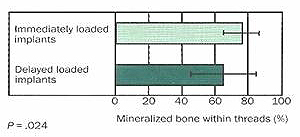 |
 |
How immediate loading of an implant affects the statistical success of that implant is probably the hottest topic in implant dentistry today. The original Branemark dogma insisted that functional stress during the healing phase would result in fibrous encapsulation, the orthopedists loaded their joints immediately, the statistics for single stage implants inadvertently placed in function was the same as buried implants etc. The question goes on and the evidence and clinical experiences seem to vary significantly.
Drs. Romanos, Siar, and Swaminathan in their article “Histologic and Histomorphometric Evaluation of Peri-Implant Bone Subjected to Immediate Loading: An Experimental Study with Macaca Fascicularis” (Int J. Oral Maxillofacial Implants 2002;17:44-51) investigated immediate loading of implants placed in healed extraction sites. Six monkeys had a bicuspid and two molars removed from the mandible bilaterally. After healing, three implants were placed on one side. After three months the buried implants were exposed and loaded with an acrylic temporary splint in occlusion. At the same time three implants were placed on the opposite side and loaded immediately with a similar acrylic temporary. One month later, fixed metal splints in occlusion were placed bilaterally. Two months later the animals were sacrificed and the bone implant interface examined.
All the implants were integrated with a slightly (not significant) greater surface of the two stage implant in contact with bone. A significantly higher amount of mineralized bone was found within the threads of the single stage implants. If this finding holds up with further experimentation, then there may be an advantage to immediate loading when splinting of the implants is possible.
A story related by Dr. Dennis Tarnow: When he was just starting to experiment with immediate loading, the level of implant failure was excessive. They would place the implants, place a temporary on them and remove the temporary with relative frequency to check mobility and hygiene. He mentioned the problems they were having to Dr. Leonard Linkow, and said that they shouldn’t remove the temporaries during the healing phase. Once Dr. Tarnow’s team stopped removing the temporaries, the success rate equaled that of the two stage implants.
If rigid continuous splinting during the healing phase results in equal success rates and an increased bone density in the threads, then we can conclude that limited functional stresses on the implant during the healing phase will increase the strength of the implant bone interface. This in turn will give a greater chance for long term success.
 |
 |
| Control - Two Stage | Immediate Load |
 |
 |
Dentures | Extreme Makeovers | Doctor's Credentials | Map & Policies | Contact Us
Home | Professional Referrals | Tidbits for Dentists | Newsletters for MDs